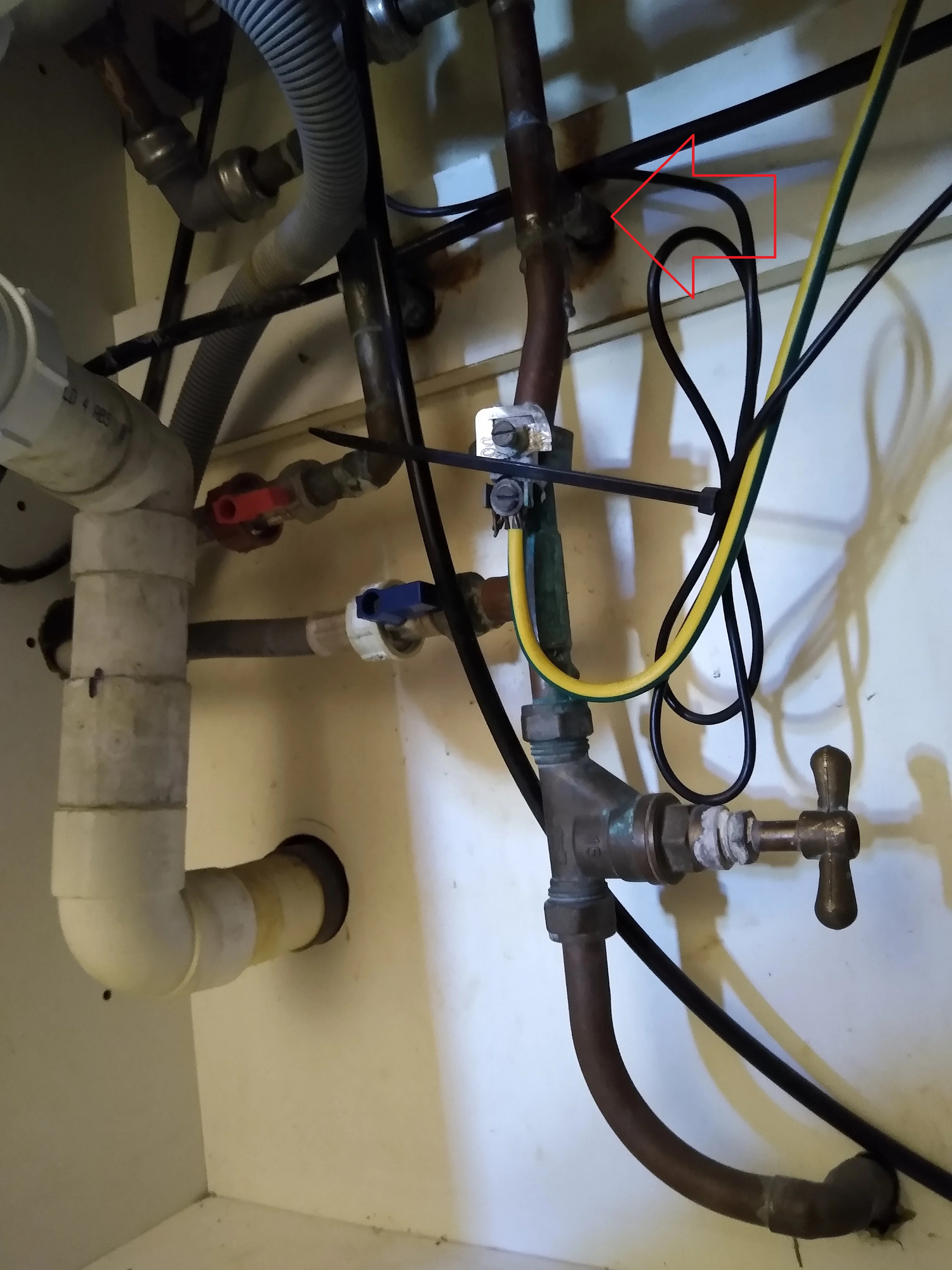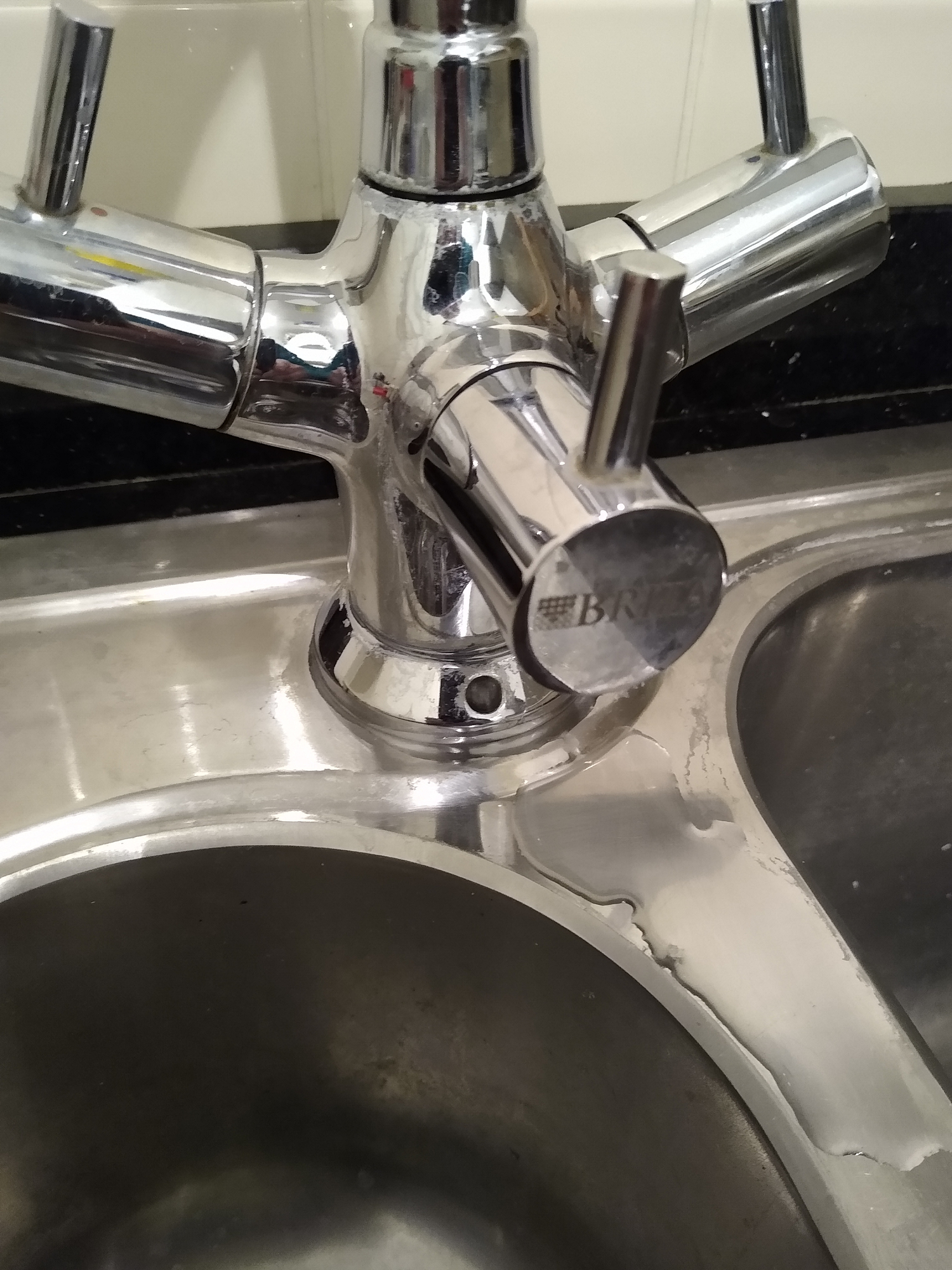We’d like to remind Forumites to please avoid political debate on the Forum.
This is to keep it a safe and useful space for MoneySaving discussions. Threads that are – or become – political in nature may be removed in line with the Forum’s rules. Thank you for your understanding.
📨 Have you signed up to the Forum's new Email Digest yet? Get a selection of trending threads sent straight to your inbox daily, weekly or monthly!
Stopcock not working
Comments
-
Wow! Can it be a gas valve, not water?
1 -
goodValue said:Below is the valve found at the location given in the Property Information Form:When taking the photo, I noticed that it might be 3-way. I can't see it being 3-way from that photo - surely there's only two pipes going to it, one at each end? Yes, that is quarter-turn, and if it doesn't turn off your water, then it ain't water. It could well be gas as said by Grumb. Do you have a gas hob? If so, fire it up and turn that valve...But there was no indication of which meter was for which flat. I think they have serial numbers on them - compare that with what's on yer bills. Then buy a control handle on eBay or similar - I would definitely want to have the ability to shut off all the water in my home at pdq notice...This stopcock seems to be just supplying the sink and the washing m/c. and so cannot be the mains stopcock.Is that white stuff gluing it in the open postion? That white stuff will be 'scale' of some sort, almost certainly from a light weap from around the spindle (easily sorted). Yes, that'll make it initially hard to turn, but once it 'breaks the seal', it should be ok.See the first smaller nut around that spindle? That's called the 'gland nut'. This nut acts on a washer underneath, usually rubber but sometimes fabric. When you tighten that nut, the washer is squished flat and squeazes out sideways and so seals against that spindle to stop water seeping by. So, that nut should be tightened just enough to stop any weep, but no more. You can undo it quite safely - the worst that'll happen is that it'll drip - and if you spray in there with silicone lubricant spray (or wipe in a gob of silicone grease - this is NOT 'sealant') before redoing the nut, it'll help to keep it all running smoothly and watertight.That stopcock is tight to move, yes? Well, just try - clockwise until it moves a bit - then back it off, and then advance a turn more. Keep going back and forth so's it becomes easier. Once fully closed, see what it has shut off! And when you reopen it, open if fully, and then close it a full turn - that'll make it less likely to bind open.Thanks for the photos.In this one, is there a pipe teeing off and going through the back of the kitchen unit at the red arrow? And where that pipe continues upwards, it definitely ONLY goes to the kitchen tap?
 1
1 -
It does have something at the back side, and there is a hole in the wall, so it's possible that it's a 'T'/divert valve. However, most likely it's like this oneJeepers_Creepers said:I can't see it being 3-way from that photo - surely there's only two pipes going to it, one at each end? Yes, that is quarter-turn, and if it doesn't turn off your water, then it ain't water. It could well be gas as said by Grumb.
gas valve, vintage
3 -
I met another resident for the first time today.He said the seller had misinformed me, and that first valve was definitely for gas.For the stopcock under the sink, with my poor eyesight and viewed straight on, I missed that branch marked with a red arrow. So this IS the mains stopcock.When working on a stopcock a couple of years ago, a mate warned me against using excessive force or lubricant (it dissolves internal grease). So I want to err on the side of caution in freeing the stopcock. Using just hand force, the pipework starts to distort accompanied by an unhealthy sound, so it might take a while to loosen it.This brings me back to thinking of why I was looking for the stopcock in the first place - a leak from the kitchen tap (shown below):
 Could a novice DIY'er tackle this problem?0
Could a novice DIY'er tackle this problem?0 -
goodValue said:I met another resident for the first time today.He said the seller had misinformed me, and that first valve was definitely for gas.For the stopcock under the sink, with my poor eyesight and viewed straight on, I missed that branch marked with a red arrow. So this IS the mains stopcock.When working on a stopcock a couple of years ago, a mate warned me against using excessive force or lubricant (it dissolves internal grease). So I want to err on the side of caution in freeing the stopcock. Using just hand force, the pipework starts to distort accompanied by an unhealthy sound, so it might take a while to loosen it.Progress
 That gascock, worth making an ID label to hang from it, and/or even painting it blue should you happen to have a pot that colour handy.Cool - that is your mains stopcock, then. Not cool - it's stuck.Ok, worth getting a tube of silicone grease - handy stuff to have for all sorts, such as easing that difficult-to-rotate tap spout, for instance. The stopcock could 'simply' be seized around where the spindle comes through - with that white scale - or it could be in the internal works.For the former, try what I said before - first wire-brush away as much of that white scale as possible. Then loosen that upper nut, and slide it up the spindle. Scrape/wire brush away any obvious debris and scale underneath, finally blowing it away with your eyes closed..., and then put a fingertip-full of sili grease in there and lightly replace the nut but don't screw it down.Now try turning the handle again. SUPPORT THE PIPEWORK as you do this. If it absolutely fails to budge without risk to the pipework, then stop - you'll need a plumber to replace it.Provided you ID your meter and also get a stopcock handle (and try it out...), then there's no rush to replace the internal stopcock, so you might decide to leave it until you have a plumber around for something else - a boiler service, for instance, but tell them what else you want done before they turn up so they'll come equipped - even send them a pic.
That gascock, worth making an ID label to hang from it, and/or even painting it blue should you happen to have a pot that colour handy.Cool - that is your mains stopcock, then. Not cool - it's stuck.Ok, worth getting a tube of silicone grease - handy stuff to have for all sorts, such as easing that difficult-to-rotate tap spout, for instance. The stopcock could 'simply' be seized around where the spindle comes through - with that white scale - or it could be in the internal works.For the former, try what I said before - first wire-brush away as much of that white scale as possible. Then loosen that upper nut, and slide it up the spindle. Scrape/wire brush away any obvious debris and scale underneath, finally blowing it away with your eyes closed..., and then put a fingertip-full of sili grease in there and lightly replace the nut but don't screw it down.Now try turning the handle again. SUPPORT THE PIPEWORK as you do this. If it absolutely fails to budge without risk to the pipework, then stop - you'll need a plumber to replace it.Provided you ID your meter and also get a stopcock handle (and try it out...), then there's no rush to replace the internal stopcock, so you might decide to leave it until you have a plumber around for something else - a boiler service, for instance, but tell them what else you want done before they turn up so they'll come equipped - even send them a pic.
2 -
goodValue said:
 Could a novice DIY'er tackle this problem?Yes, but it depends on how competent a DIY novice you are
Could a novice DIY'er tackle this problem?Yes, but it depends on how competent a DIY novice you are It ain't the easiest tap to cut your plumbing teeth on. I've never come across one of these in person.It's a Bristan? Do your homework - ID the actual model, and see what info is out there - Bristan could well have an exploded diagram of it.Where EXACTLY is it leaking from - that's important. And is it all the time the tap is running, hot, cold, even when it's off?1
It ain't the easiest tap to cut your plumbing teeth on. I've never come across one of these in person.It's a Bristan? Do your homework - ID the actual model, and see what info is out there - Bristan could well have an exploded diagram of it.Where EXACTLY is it leaking from - that's important. And is it all the time the tap is running, hot, cold, even when it's off?1 -
That looks to be a BRITA filtered water tap not Bristan!
Based on the front with the Brita name printed on it. Filtered water on the front control plus Hot (left usually) and Cold taps.
Could be any number of makers? But https://www.taps4less.com/pages/ArchiveP.asp?id=BRITA-TITANBS is a possible match?
2 -
Where EXACTLY is it leaking from - that's important. And is it all the time the tap is running, hot, cold, even when it's off?
It's leaking from the base of the tap.
The photo shows what there is after a couple of hours without using the tap.
When running the tap, you can actually see water coming out.
So it is a significant problem, but no emergency.
I'll concentrate on freeing the stopcock first.
0 -
The water appears or gathers or forms at the base of the tap, but where EXACTLY does it exit - come out?
1 -
Rodders53 said:That looks to be a BRITA filtered water tap not Bristan!
Based on the front with the Brita name printed on it. Filtered water on the front control plus Hot (left usually) and Cold taps.
Could be any number of makers? But https://www.taps4less.com/pages/ArchiveP.asp?id=BRITA-TITANBS is a possible match?Yes, it is a Brita.When I looked on the Brita website, their current models go for about £440!I couldn't see any of their older models.Your link does show the model I have, and there is an installation guide there. I'll take a look at thatwhen the stopcock is working.0
Confirm your email address to Create Threads and Reply

Categories
- All Categories
- 352.9K Banking & Borrowing
- 253.9K Reduce Debt & Boost Income
- 454.7K Spending & Discounts
- 246K Work, Benefits & Business
- 602.1K Mortgages, Homes & Bills
- 177.8K Life & Family
- 259.9K Travel & Transport
- 1.5M Hobbies & Leisure
- 16K Discuss & Feedback
- 37.7K Read-Only Boards





